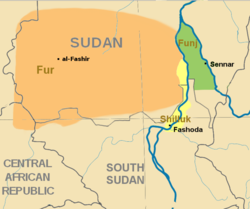Shilluk Kingdom
| Shilluk (Chollo) Kingdom | ||||||||||||
| Läg Cøllø or "Pödh Cøllø" or "Sudan" in Arabic | ||||||||||||
|
||||||||||||
|
Shilluk Kingdom (yellow) and its neighbors
|
||||||||||||
| Capital | Fashoda | |||||||||||
| Languages | Shilluk | |||||||||||
| Religion | African Traditional Religion imperial cult later islam (late 18th century ) | |||||||||||
| Government | Divine monarchy | |||||||||||
| Rädh | ||||||||||||
| • | 1490–1517 | Nyikaangø | ||||||||||
| • | 17th century | Odaagø Ocøllø | ||||||||||
| • | 17th century | Rädh Tugø | ||||||||||
| Historical era | Late medieval to early modern period | |||||||||||
| • | Established | c. 1490 | ||||||||||
| • | Disestablished | 1865 | ||||||||||
|
||||||||||||
| Today part of | South Sudan | |||||||||||
The Shilluk Kingdom was located along the banks of the White Nile river in modern South Sudan. Its capital and royal residence was in the town of Fashoda. According to their folk history and neighboring accounts, the kingdom was founded during the mid-fifteenth century CE by its first ruler, the demigod Nyikang. During the nineteenth century, the Shilluk were affected by military assaults from the Ottoman Empire and later British colonization in Anglo-Egyptian Sudan. The Shilluk king is currently not an independent political leader, but a traditional chieftain within the governments of South Sudan and Sudan.
The monarchy (the Reth) has been political and religious in nature. The monarch guaranteed social order; his health and the health of the nation were intertwined. Worship is performed in rituals inspired by the national myth of Nyikang, the first Reth. The Shilluk monarchy and the beliefs of its people was studied in 1911 by Charles Seligman and in 1916 by British anthropologist James George Frazer in The Golden Bough. Seligman described the Shilluk form of government as a "sacred kingship".
...
Wikipedia



